Anna’s Hummingbird, a dazzling resident of western North America, emerges as a testament to nature’s vibrant palette and adaptability.
Scientifically known as Calypte anna, this charismatic bird enchants observers with its striking iridescent plumage and distinctive behavior.
Named after Anna Masséna, Duchess of Rivoli, by renowned French naturalist René Lesson, the species showcases a fascinating blend of territorial displays, agile flight patterns, and a penchant for urban habitats.
With a vibrant magenta crown and throat that shimmers in the sunlight, Anna’s Hummingbird stands out as a jewel among its feathered counterparts.
Its adaptability to human-altered landscapes, including gardens and urban areas, adds an intriguing dimension to its ecological niche.
As we delve into the intricate details of Anna’s Hummingbird, we uncover not just a bird of breathtaking beauty but a resilient and captivating ambassador of the avian world.
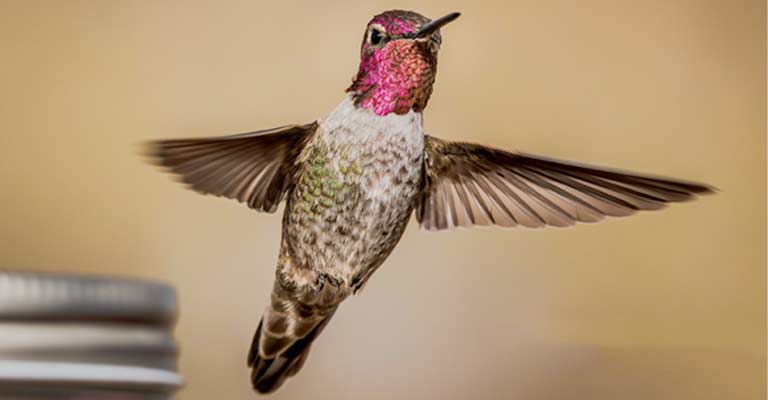
Identifying Characteristics of Anna’s Hummingbird
Identifying Anna’s Hummingbird (Calypte anna) involves keen observation of its distinctive physical features, behaviors, and habitat preferences.
As a species native to western North America, particularly along the Pacific Coast, this charismatic hummingbird possesses unique characteristics that set it apart.
Size and Shape
Anna’s Hummingbird is a medium-sized hummingbird with a length of approximately 3.9 to 4.3 inches (10 to 11 cm).
Its slender, streamlined body and long, straight bill contribute to its aerodynamic silhouette, distinguishing it from other hummingbird species.
Coloration
The male Anna’s Hummingbird is renowned for its vibrant iridescence. Its crown and throat exhibit a striking magenta-red hue that glows vividly in direct sunlight.
The rest of the body has a combination of iridescent green and grayish tones. The female lacks the intense colors but displays a more subdued palette, featuring grayish-green feathers.
Gorget Display
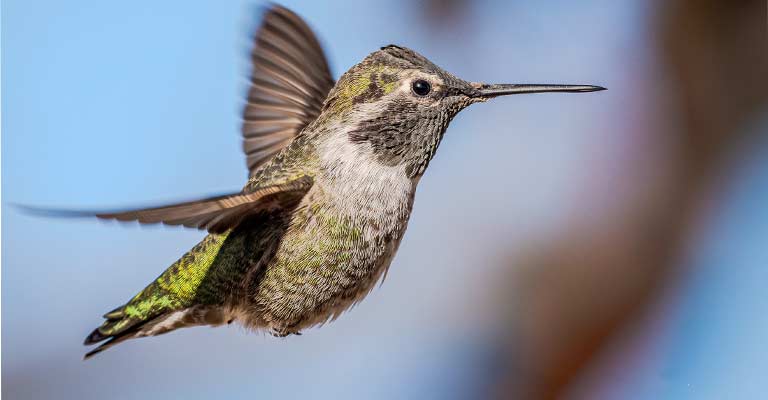
The iridescent throat, or gorget, is a key identifier, especially in males.
During courtship displays or territorial confrontations, the male Anna’s Hummingbird elevates and fans its gorget, creating a dazzling display of colors to attract mates or ward off rivals.
Tail Characteristics
Anna’s Hummingbird has a slightly rounded tail with a dark base and white tips on the outer feathers. This tail configuration is distinctive and aids in differentiating it from other hummingbird species.
Vocalizations
While not known for elaborate songs, Anna’s Hummingbirds produce a variety of chirps, squeaks, and buzzes.
The vocalizations are often used in communication, particularly during courtship rituals and interactions with other hummingbirds.
Flight Patterns
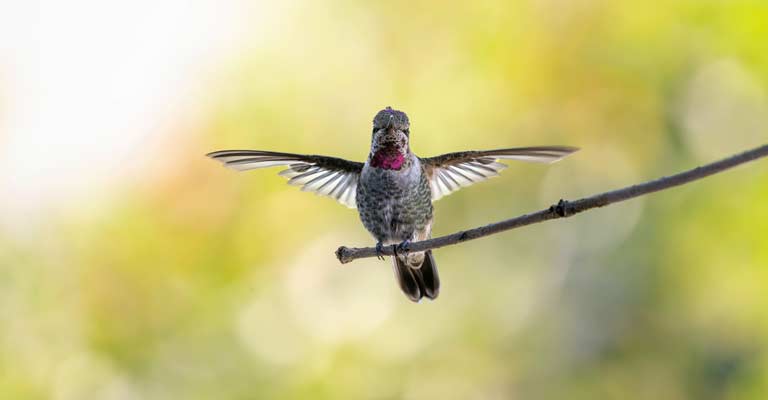
Anna’s Hummingbirds are agile flyers with the ability to hover in mid-air, darting rapidly between flowers to feed.
Their flight is characterized by swift and direct movements, and they often emit distinct sounds produced by their wingbeats.
Seasonal Variations
In colder regions, Anna’s Hummingbirds exhibit a degree of seasonal adaptability. During winter, they may survive by entering a state of torpor during the night to conserve energy.
Distinctive Behaviors
Observing behaviors such as territorial displays, courtship rituals, and feeding habits contributes to accurate identification.
The distinctive characteristics of Anna’s Hummingbird become more evident when these behaviors are witnessed in their natural habitat.
Identifying Anna’s Hummingbird involves a holistic examination of its size, coloration, behaviors, and habitat preferences.
The combination of a vibrant gorget, distinct flight patterns, and adaptability to various environments makes this species a captivating and easily recognizable member of the hummingbird family.
Taxonomy of Anna’s Hummingbird
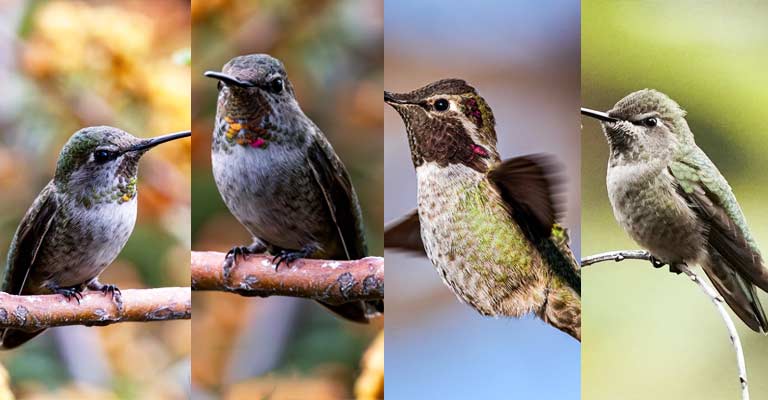
Here is a table summarizing the taxonomy details of Anna’s Hummingbird (Calypte anna):
| Taxonomic Rank | Classification |
| Domain | Eukaryota |
| Kingdom | Animalia |
| Phylum | Chordata |
| Class | Aves |
| Clade | Strisores |
| Order | Apodiformes |
| Family | Trochilidae |
| Genus | Calypte |
| Species | C. anna |
This table outlines the hierarchical classification of Anna’s Hummingbird, starting from the broadest taxonomic categories (Domain, Kingdom) and progressing to more specific ones (Order, Family, Genus, and Species).
The specific epithet “anna” is used to denote this particular species within the Calypte genus.
It is classified under the Trochilidae family, known for hummingbirds. Within this family, the species is part of the Calypte genus and C. anna species.
Notable for its vibrant colors and adaptability to various environments, Anna’s Hummingbird showcases the intricate web of its avian lineage, illustrating its unique position in the taxonomic hierarchy of the animal kingdom.
Anna’s Hummingbird Life History
The life history of Anna’s Hummingbird (Calypte anna) unveils a captivating narrative of resilience and adaptability in the western realms of North America.
This charismatic hummingbird, with its vibrant colors and acrobatic flight, weaves a story that encompasses its dietary preferences, habitat choices, and the challenges it faces in the realms of breeding, health, and conservation.
Food
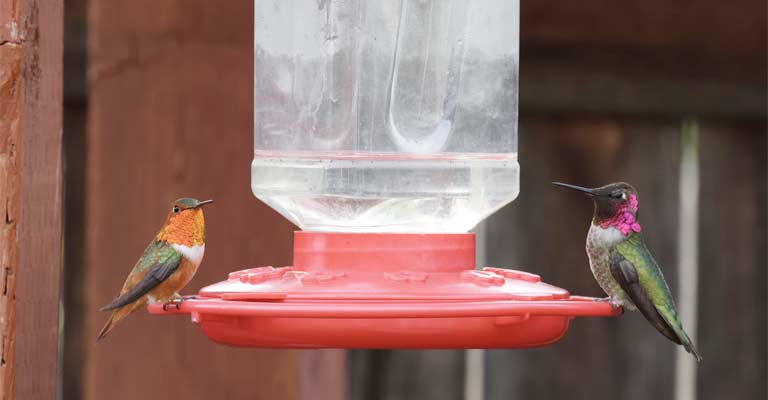
Anna’s Hummingbird sustains itself primarily on nectar from flowering plants, showcasing a particular affinity for tubular blooms.
Their specialized bill and long tongue enable them to extract nectar efficiently, and they supplement their diet with small insects and spiders for essential proteins.
Habitat
These hummingbirds are remarkably adaptable, thriving in various habitats ranging from coastal scrublands and woodlands to urban and suburban areas.
Their ability to coexist with human-altered landscapes sets them apart, making gardens and parks common sightings.
Range Map
Anna’s Hummingbirds inhabit the western coast of North America, spanning from southern Alaska to Baja California.
A range map vividly illustrates their presence, emphasizing their year-round residency in many regions and showcasing the extent of their migratory patterns.
Nesting
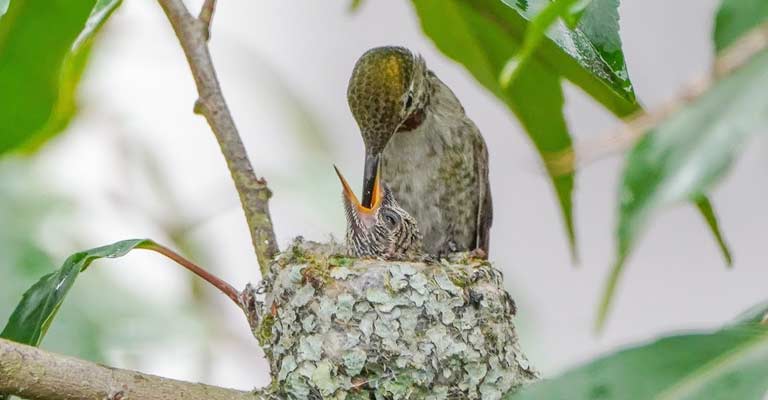
Nesting is a meticulous affair for Anna’s Hummingbird. The female constructs a cup-shaped nest using plant fibers, spider silk, and downy materials, often camouflaged within vegetation.
Nest placement can vary, from shrubs to tree branches, providing a secure haven for eggs and nestlings.
Here is a table summarizing the nesting details of Anna’s Hummingbird (Calypte anna):
| Nesting Details | Facts |
| Clutch Size | Typically consists of 2 eggs |
| Number of Broods | Often raises 2 or more broods per breeding season |
| Egg Length | Approximately 1.3 cm (0.5 inches) |
| Egg Width | Around 0.8 cm (0.3 inches) |
| Incubation Period | Lasts about 14 to 19 days |
| Nestling Period | Approximately 18 to 23 days |
| Egg Description | Tiny, white or off-white with a smooth surface |
| Nest Construction | Compact cup-shaped nest secured on branches or structures |
| Nest Materials | Built with plant fibers, spider silk, and downy materials |
| Parental Involvement | Both males and females contribute to incubation and chick-rearing |
| Nest Location | Varied, including tree branches, shrubs, or man-made structures |
Breeding
During the breeding season, males engage in intricate courtship displays to attract females. The dazzling gorget display, with vibrant colors on the throat, is a key feature.
Females lay a clutch of two eggs, and both parents contribute to incubation and chick-rearing responsibilities.
Diseases
Anna’s Hummingbirds may face health challenges, including infections caused by mites and fungi. Monitoring for signs of disease, such as lethargy or abnormal behavior, is crucial for early detection and intervention.
Treatment
Mitigating disease risks involves maintaining clean feeding stations, providing a suitable environment, and, in cases of illness, seeking veterinary assistance or rehabilitation support. Proper nutrition and hygiene play pivotal roles in their well-being.
Conservation
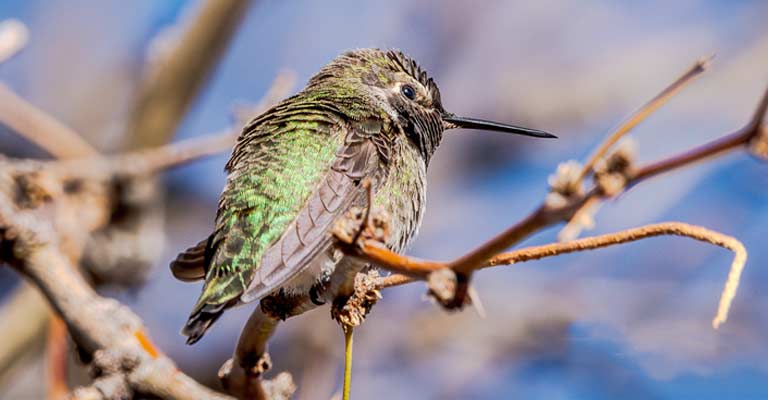
Despite their adaptability, Anna’s Hummingbirds face conservation challenges due to habitat loss, climate change, and human activities.
Conservation efforts focus on preserving natural habitats, promoting sustainable practices, and raising awareness about the importance of these vibrant pollinators in maintaining ecosystem balance.
The life history of Anna’s Hummingbird is a testament to its remarkable ability to thrive in diverse environments, contributing to the ecological tapestry of the western coast of North America.
Understanding and appreciating the nuances of their dietary habits, nesting rituals, and conservation needs are imperative for ensuring the continued vibrancy of this enchanting species.
10 Fun Facts About Anna’s Hummingbird
Anna’s Hummingbird, with its radiant colors and lively demeanor, is a charismatic species that captivates bird enthusiasts. Here are 10 fascinating facts that illuminate the charm and uniqueness of this remarkable hummingbird:
- Vibrant Gorget: The male Anna’s Hummingbird boasts a dazzling iridescent gorget on its throat, displaying vibrant shades of magenta and red. This feature is prominently exhibited during courtship displays to attract mates.
- Year-Round Residents: Unlike many other hummingbird species, Anna’s Hummingbirds are non-migratory in several regions, residing in their habitats year-round. This adaptability to varied climates contributes to their prevalence in urban and suburban areas.
- Adaptation to Urban Life: Anna’s Hummingbirds have shown a remarkable ability to adapt to human-altered landscapes, making gardens, parks, and urban environments common places to spot these tiny wonders.
- High Metabolism: With a heart rate that can exceed 1,200 beats per minute and a rapid metabolism, Anna’s Hummingbirds need to feed frequently. They consume nectar from flowers, supplemented by small insects and spiders.
- Intricate Courtship Displays: Males engage in elaborate courtship displays, showcasing their acrobatic flight skills and the vibrant colors of their gorget. These displays involve impressive aerial maneuvers to attract potential mates.
- Nest Construction: The female Anna’s Hummingbird meticulously builds a cup-shaped nest using plant fibers, spider silk, and downy materials. The nests are often camouflaged within vegetation, providing a secure environment for eggs and nestlings.
- Multiple Broods: Anna’s Hummingbirds are known for raising multiple broods in a single breeding season. This adaptability contributes to their reproductive success and population sustainability.
- Distinctive Sounds: While not known for elaborate songs, Anna’s Hummingbirds produce various vocalizations, including chirps and buzzing sounds. These sounds play a role in communication during courtship and territorial displays.
- Territorial Behavior: These hummingbirds exhibit territorial behavior, defending feeding and nesting areas from other hummingbirds and potential threats. This behavior contributes to their survival and reproductive success.
- Conservation Challenges: Despite their adaptability, Anna’s Hummingbirds face conservation challenges, including habitat loss and climate change. Conservation efforts are essential to safeguard their habitats and ensure their continued presence in diverse ecosystems.
Anna’s Hummingbird, with its vibrant colors, adaptable nature, and intriguing behaviors, stands out as a jewel in the avian kingdom.
These fun facts offer a glimpse into the fascinating world of this tiny yet resilient hummingbird, captivating the hearts of bird watchers and nature enthusiasts alike.
Wrapping Up
In the enchanting world of avifauna, Anna’s Hummingbird emerges as a charismatic ambassador, blending vibrant colors, agile flight, and resilient adaptability.
Its year-round presence, intricate courtship displays, and urban coexistence highlight a remarkable life history, capturing the hearts of bird enthusiasts.
From the intricacies of courtship dances to nesting rituals and their harmonious coexistence with urban life, these hummingbirds embody resilience and charm.
Understanding the nuances of their behavior and unique features deepens our appreciation for this charismatic species, showcasing the remarkable ways in which Anna’s Hummingbirds contribute to the ecological vibrancy of western North America.